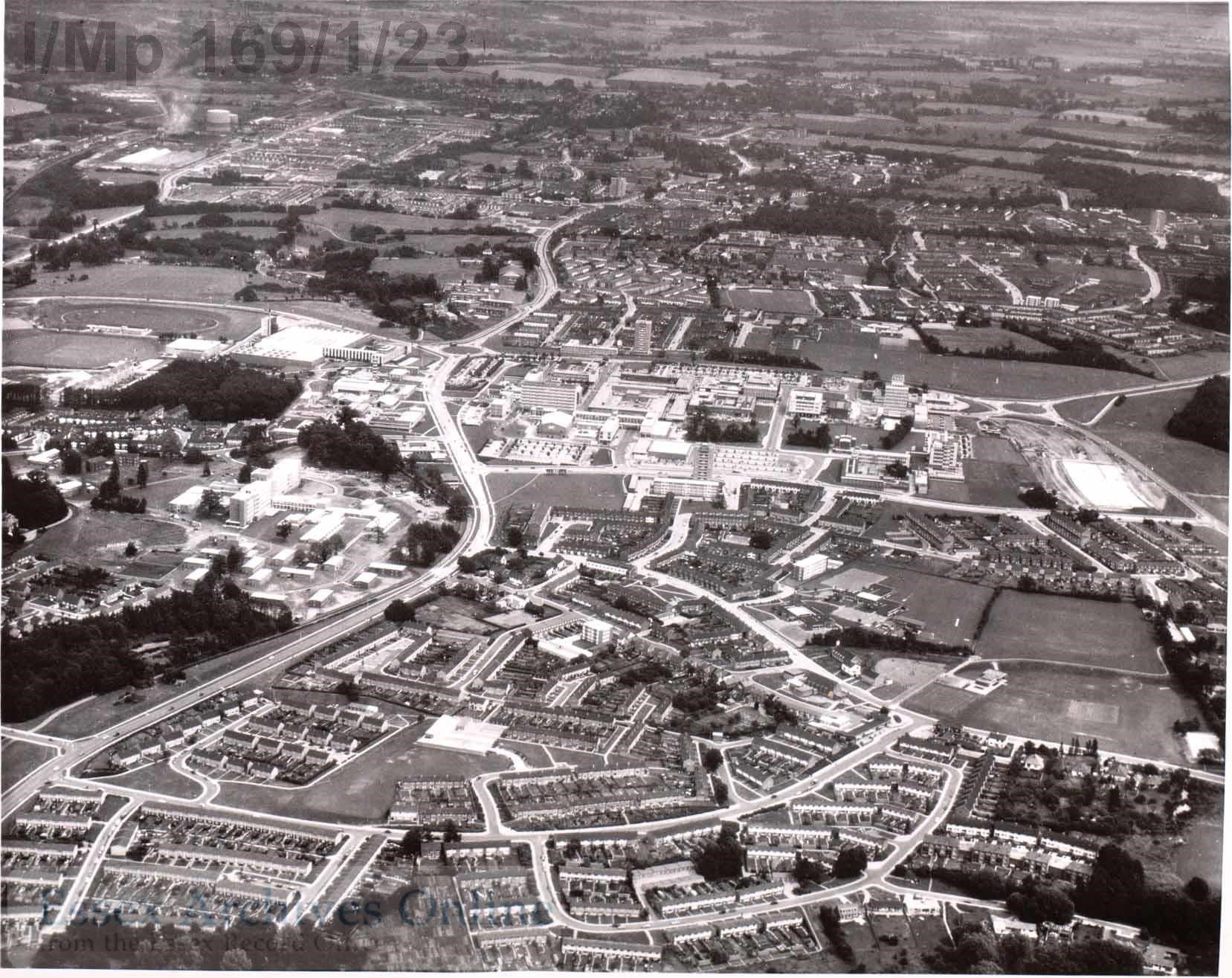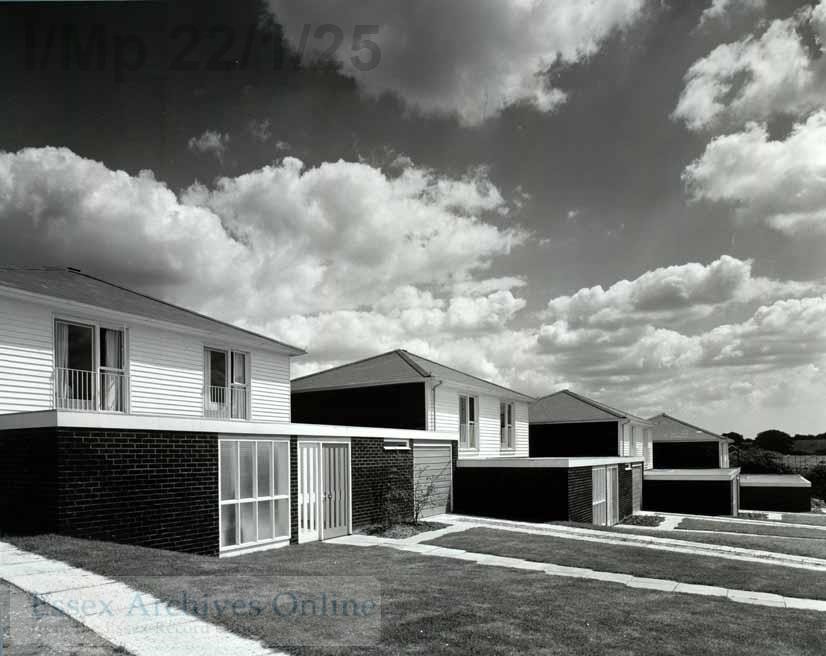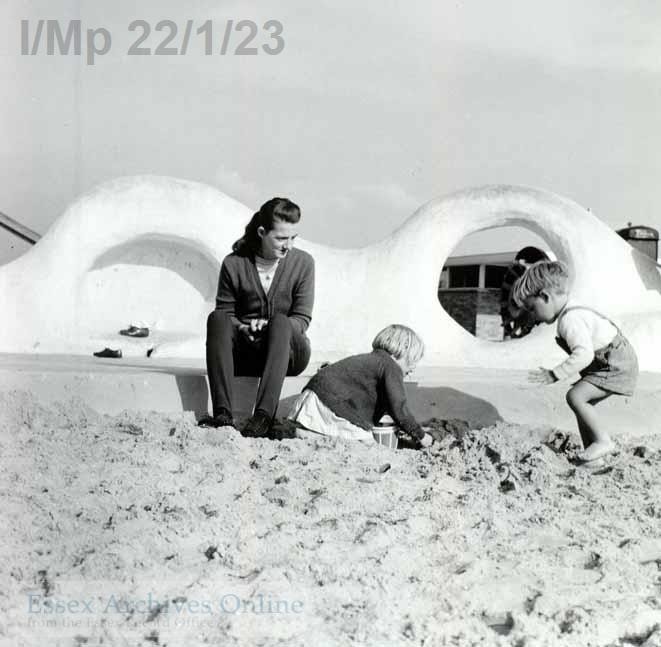- Introduction
- Overview of the Harlow and Basildon collections at the ERO
- What can I find in the collection?
- Importance beyond Essex
- How to access the collection
- Recordings in the Essex Sound and Video Archive
- Other new towns in the UK and Ireland
- Further reading and other resources
Harlow and Basildon were part of the New Town movement to help rebuild the country after World War Two. They were a key element of the ‘New Jerusalem’; created by a reforming Government which also founded the NHS. Harlow and Basildon provided new homes for families who were living in overcrowded and often bomb-damaged conditions in the East End of London. The concept behind New Towns was to ensure essential amenities for daily living were within close proximity. These encompassed healthcare facilities, educational institutions, retail outlets, green spaces, and employment opportunities. Development Corporations were established to create New Towns. They had a much wider range of powers and responsibilities than local councils. The New Town Development Corporation records are much richer resources than council papers, providing fascinating insights into many aspects of 20th century life.
At the Essex Record Office (ERO) we hold the records of the two bodies appointed to create New Towns in Essex: Harlow Development Corporation and Basildon Development Corporation. These records were the working documents used to design and build the new town. Local council records tend to be mainly reports and council minutes. Development Corporations were building whole new communities. As a result, a variety of additional documents are available, such as publicity brochures, maps, plans, architectural drawings, and a rich collection of photographs.
The Harlow and Basildon Development Corporations records cover their entire history, from their creation in 1947 and 1949 up to their dissolution in 1980 and 1986.
The Harlow Development Corporation archive comprises 5343 records in 596 boxes. This includes 7913 plans; 1331 photographs and 501 photographic negative glass plates; 47 reels of microfilms, and seven tape recordings.
The Basildon Development Corporation archive comprises 1055 boxes, including more than 2000 plans; and many photographs, microfilms, videos, and tape recordings.
The amount and quality of information kept in these records will allow you to undertake research on practically any aspect of Harlow and Basildon New Towns. Some examples of subjects you might be interested in include:
Urban planning
New Towns were the most ambitious urban planning projects ever carried out in the UK. Studying the records for Harlow and Basildon can help reveal why decisions were made and how plans changed over time. There is renewed interest in planning principles that shaped Harlow and Basildon including: a 15-minute neighbourhood where you can have your daily needs met nearby; safe cycle routes; and well-design green spaces. Records relating to urban planning include:
Harlow: A/TH 1/4 – Planning Board minutes and drawings; A/TH 2/2/3 – Naming of areas; A/TH 2/2/4 – Town Planning
Basildon: A8791 – plans presented at Board meetings, files relating to Town Centre development, commercial developments, Pitsea Centre and market, and industrial areas and factories

Aerial view of Harlow New Town by Aerofilms Ltd. of Boreham Wood, Hertfordshire, 1965
Housing
Development Corporations worked on all aspects, from design and building homes to their occupation by new tenants and owners. The records show what types of dwellings were built where, together with contracts for construction, cost estimates and bills. You can find out how areas were named and numbered. There are many drawings for the designs of new homes. Records relating to housing include:
Harlow: A/TH 2/2/9 – Housing Design, Housing Applications, Transfers and Complaints, Housing Architectural Competitions, Do-it-yourself Housing etc; A/TH 3/10 – Social Development Dept Photographic Collection
Basildon: A/TB 1/2/25/1 – Records of the Housing Committee; A8891 – Records of the Housing Committees management and general files; publications, reports etc.; photographs
Architecture and Interior Design
Some of the most important British architects including Frederick Gibberd and Basil Spence were involved in designs for Harlow and Basildon. The records contain plans, drawings, sketches and photographs of their work as well as appointment agreements and technical guidelines. Landscape design also attracted some of the 20th century’s most important figures. Sylvia Crowe collaborated with Frederick Gibberd on Harlow Town Park.
The records don’t stop on the outside; you will find designs and photographs for domestic interiors, as well as showrooms and exhibitions. There is a renewed interest today in design from the 1950s through to the 1980s, which can be explored using the New Town records. Records relating to architecture and interior design include:
Harlow: A/TH 6/1 – Architects’ files, plans and microfilms; A/TH 3/10/33/14 – Social Development Dept Photographic Collection
Basildon: A/TB 2/10 – Architects’ Drawings; A8389 – Administration Dept, being P.R. photos, literature, videos and files showing interiors of houses and public buildings

Photograph of housing at Lee Chapel South, Basildon New Town.
‘A Stanland Photograph’ by C.G. Stanford of Little Waltham, c. 1965
Engineering
You can explore the fundamental concepts of building a New Town through the engineering collection which includes a range of documents and plans covering road layout and construction, drainage systems, and streetlighting designs etc. Records relating to engineering include:
Harlow: A/TH 6/2 – Engineers’ files and microfiches; A/TH 2/2/9 – Administration dept: design of roads files
Basildon: A8287 – files, photographs, inc. aerial photographs, and microfilms of correspondence of the Engineering Dept; A8974 – negatives (and a few photographs and slides) taken of work in progress by the Engineering Dept
Public buildings and community life
New towns were not just about houses but creating a whole community. As well as homes, there are designs for schools, shops, churches, the market, public houses, restaurants, and other amenities.
These new communities found many ways for people to come together. You can find out more about the large range of clubs and societies available to residents including music, theatre, arts, and youth clubs. Records relating to public buildings and community life include:
Harlow: A/TH 3/4 – Social Development Dept Education files; A/TH 3/2/6 – Social Development Dept, Community: Religious Organisations
Basildon: A8791 – files relating to Town Centre development, other commercial developments, Pitsea Centre and market, and industrial areas and factories
Public Art and a sense of place
Today, Harlow is known as Sculpture Town and has one of the most significant collections of public art in the UK. Basildon and Harlow both are well known for their strong ties with arts. You can find material about some of the 20th century’s most important artists including Henry Moore, Barbara Hepworth, Gerda Rubinstein, Wendy Taylor and Elizabeth Frink. Records relating to public art and a sense of place include:
Harlow: A/TH 3/2/8 – Social Development Dept, Community: Culture including files on Harlow Arts Council, Parndon Mill Art Gallery; A/TH 3/10 – Social Development Dept Photographic Collection
Basildon: A12921 – print of design drawing and specification by Rowland Emett for sculpture ‘Cats Cradle Pussie Willow III’, installed in Eastgate Shopping Mall, Basildon, 1981
Working in the New Town
As well as a new house, people arriving in the New Town could find a new job in a modern factory. There are files, drawings and photographs of the new industrial areas; and studies and statistics about the jobs created. Records relating to working in the New Town include:
Harlow: A/TH 2/5 – Administration Dept Commerce and Industry files
Basildon: A8791 – Administration Dept industrial areas and factories files
A healthy place to live
Creating an environment that was healthy was a priority for the Development Corporations. Health in the New Towns can be explored by looking at files on health centres, hospitals and social welfare. Records relating to health and social care include:
Harlow: A/TH 3 – Social Development Dept files
Basildon: A/TB 1/2/6/2 – Joint Welfare and Safety Committee minutes and papers

Photograph of woman and two children in sandpit at Basildon New Town. ‘A Stanland photograph’ by C.G. Stanford of Little Waltham, c. 1965
Sport and recreation
Being healthy was also about being able to take exercise and keep fit. The files and photographs detail the many sports clubs, their premises, sporting events and competitions. Records relating to sport and recreation include:
Harlow: A/TH 2/1/10 – Admin Dept, Development Areas: Town Centre inc. files on Sports Area and Stadium
Basildon: A8389 – Social and Leisure Facilities files
Visitors from across the UK and overseas came to Harlow and Basildon to see the New Towns and learn about how they were being developed. Frederick Gibberd was especially influential overseas, and his books and other writing helped shape the New Towns built around Paris. The New Towns were prominent in public life in the UK, and there are photographs and other documents from royal visits.
In the Essex Archives Online website, the ‘How to Search our archives’ link under user guides at the top of the homepage has very helpful guidance for searching the catalogue.
The catalogue reference for the Harlow Development Corporation is A/TH and for the Basildon Development Corporation is A/TB.
You will need to visit to visit the Essex Record Office in Chelmsford to consult original documents. Information about visiting can be found on our website: https://www.essexrecordoffice.co.uk/visit-us/
The Essex Sound and Video Archive at the ERO preserves many recordings relating to Harlow and Basildon. These recordings provide a unique insight into life in both towns, through the voices of those who lived and worked there. They include oral histories with residents, radio programmes, recordings of events, talks and conferences, and talking newspapers. The ESVA also preserves hospital television programmes and cine-films recorded in Harlow and Basildon, and copies of relevant films in the East Anglian Film Archive. For more information, see Harlow and Basildon in the Essex Sound and Video Archive.
Harlow and Basildon are just two of the New Towns built after World War Two. The New Jerusalems Project website is a useful resource for information on several other new towns in England: https://www.newjerusalems.info/ . For researchers, this opens up the potential for studies that compare several towns. For heritage, arts and cultural organisations, you can get inspiration and share ideas from the ways other New Towns have used the archives.
At the Essex Record Office, there is an extensive local studies reference library holding many books relating to Harlow and Basildon New Towns. You can search for items of interest on Essex Archives Online.
New Towns: the rise, fall and rebirth. By Katy Lock and Hugh Ellis. RIBA publishing. 2020. A good starting point for those interested in post-war New Towns in the UK. The book sets out to challenge many of the negative preconceptions associated with the New Town Movement. Chapter five is a case study of Harlow.
The Invention of Essex. By Tim Burrows. Profile Books. 2023. Uses the County of Essex to tell a wider story about 20th century British History. The New Towns of Harlow and Basildon feature prominently.
Frederick Gibberd. By Christine Hui Lan Manley. RIBA publishing and Historic England. 2017. A biography of one of the most important figures in post-war planning. Gibberd was an architect, masterplanner and landscape architect. Chapter four focuses on his work in Harlow New Town, where he also lived.
Radical Essex. Edited by Hayley Dixon and Joe Hill. Focal Point Gallery. 2018. A series of essays exploring the ‘radical’ 20th century history of Essex. Chapter three by Charles Holland reviews modernist architecture, including many examples from Harlow and Basildon. In chapter four, Gillian Darley charts the development of Basildon and Harlow from the 1930s to the present.
Harlow Museum collection is another important source of information to better understand the development of the New Town. Its collection contains a substantial number of documents, especially newspapers and magazines. It also holds the entire photographic collection of the Social Development Department of the Development Corporation, and some of the Architect’s Department plans and drawings.
Town and Country Planning Association. The historical issues of the journal, which includes articles about the development of Harlow and Basildon can be accessed here: https://archive.tcpa.org.uk/archive/journals
Royal Institute of British Architects. Their catalogue contains the working papers and drawings of architects, and architectural journals and books. The catalogue is online and can be searched for material related to Harlow and Basildon.
National Government papers. The reports, letters, and other working documents created by civil servants are held in The National Archives (TNA) in Kew. These are mostly catalogued as HLG (Ministry of Town and Country Planning). The National Archives also holds the corporate archives of the Commission for the New Towns and its successor English Partnerships. There is a guide on ‘How to look for records of towns and cities’.
ERO Blog post on Sculpture in Harlow New Town. Search for “harlow sculpture”.
